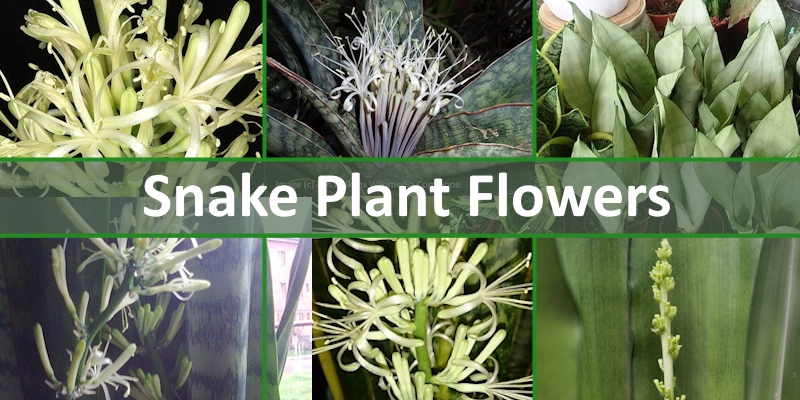
Snake Plant Flowers: Meaning, Care, and Why They Bloom Indoors

Snake plant flowers are a rare treat for patient plant parents. These low-maintenance, air-purifying beauties occasionally send up a tall, fragrant bloom indoors. If you’ve spotted yours flowering, you’re probably wondering what snake plant flowers mean, how long they last, and what to do next.
Table of Contents
- Snake Plant Flowers—A Rare, Sticky Surprise
- What Snake Plant Flowers Actually Look Like
- Why Do Snake Plants Bloom? (It’s Not Just Luck)
- Snake Plant Flowers—A Good Sign or a Cry for Help?
- How to Get a Snake Plant to Bloom
- Snake Plant Varieties That Are More Likely to Bloom
- Rare Snake Plant Cultivars and Collector Favorites
- How to Care for Snake Plant Flowers
- What to Do After Your Snake Plant Flowers
- Snake Plant Flowers: FAQs
But here’s the thing—most people have no idea what to make of it.
A sudden snake plant bloom can spark confusion, even concern. Some wonder if it’s a fluke. Others worry it’s a sign the plant is stressed—or worse, dying. Add in the sticky nectar, nighttime scent, and dramatic height, and it’s easy to go from curious to full-blown plant panic.
That’s a shame because understanding why Dracaena trifasciata flowers—and what it means—can shift the experience from mystery to milestone. With the proper care and conditions, a snake plant bloom doesn’t have to be alarming. It can be a fascinating, rewarding event rooted in your plant’s natural rhythm.
Read on to discover what the flowers really mean, how to encourage them (if you want to), and how to care for snake plants so that they bloom indoors without breaking a sweat. Even if you don’t have a green thumb, you can get your snake plant to flower.
Snake Plant Flowers—A Rare, Sticky Surprise
Snake plant blooms are the kind of weird, wonderful reward that makes you stop mid-water and whisper, “Wait—what is that?”
One day, it’s all swordlike, stiff leaves doing their stoic thing. The next? A tall, alien-looking stalk shoots up overnight like it’s got somewhere urgent to be. Then the flowers open—cream-colored, long-lashed little things that smell like sweet perfume in the evening air. Some say jasmine. Others say vanilla and cloves. Either way, it’s unexpected magic.
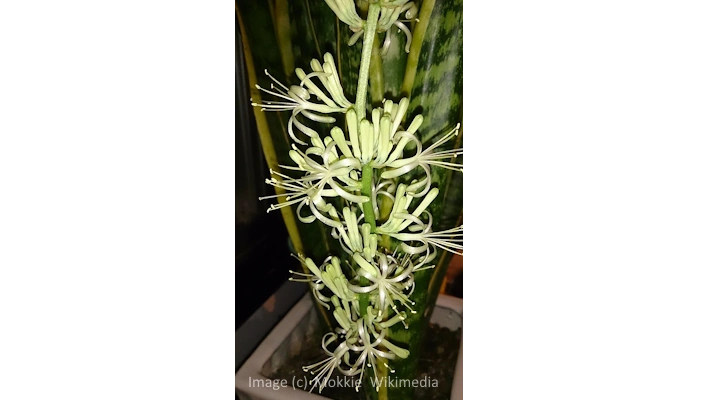
And the sap? Yep, they drip. Sticky, glossy nectar runs down the stalk like your plant’s sweating sugar. It might look messy or even a little gross, but don’t worry—it’s harmless and totally normal.
Most of us never see it happen. That’s part of the charm. When a snake plant flowers, it usually means the plant’s either very mature or feeling a bit stressed—and sometimes, both. It’s less a cry for help and more a last-ditch “I’m gonna bloom before I go” type of move.
Did you know that snake plants and their flowers have more than aesthetic value? Not many people know this, but snake plants help purify the air, boost indoor humidity, and are super easy to care for. Discover more in my article about the 17 Underrated Snake Plant Benefits you’ll love.
What Do Snake Plant Flowers Look Like?
Snake plant flowers grow on tall, slender stalks with clusters of narrow, tubular blooms in creamy white or pale green. Each flower has delicate filaments and a soft, silky texture. The blooms often release sticky nectar and open more fully at night, giving off a sweet, fragrant scent.
Snake Plant Flower Color and Shape
The bloom stalk is tall and spindly, with clusters of white-green flowers that look like little fireworks frozen in bloom. Clusters of narrow, tubular flowers in creamy white or pale green line the stalk. Each flower has long, delicate filaments and a silky, waxy texture that catches the light and feels surprisingly soft to the touch.
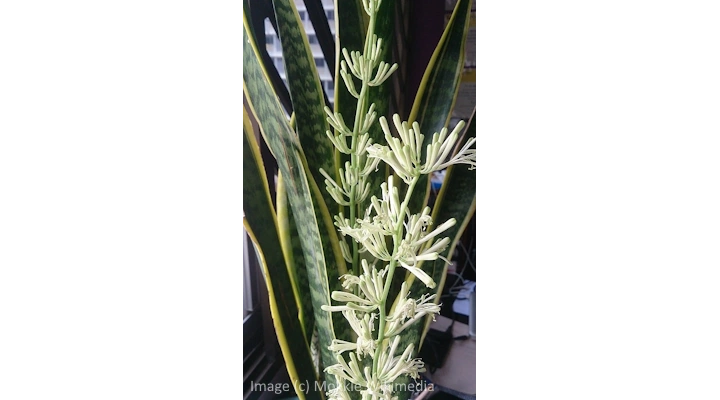
Do Snake Plant Flowers Smell?
The fragrance is strongest at night—rich, floral, and almost intoxicating. Many describe it as a blend of jasmine, vanilla, and honey, with a powdery sweetness that lingers in the air. It’s surprisingly intense for such a subtle plant, turning a quiet room into a mini perfume shop.
The Sticky Stuff: What Is That Nectar from Snake Plant Flowers?
Snake plant flowers exude thick, shiny nectar that glistens on the petals or drips onto leaves. It feels like plant syrup—clear, sugary, and slightly tacky. This nectar isn’t harmful; it’s just part of the bloom’s natural process and was meant to attract night-pollinating insects in the wild.
Photos & Community Snake Plant Flower Gallery
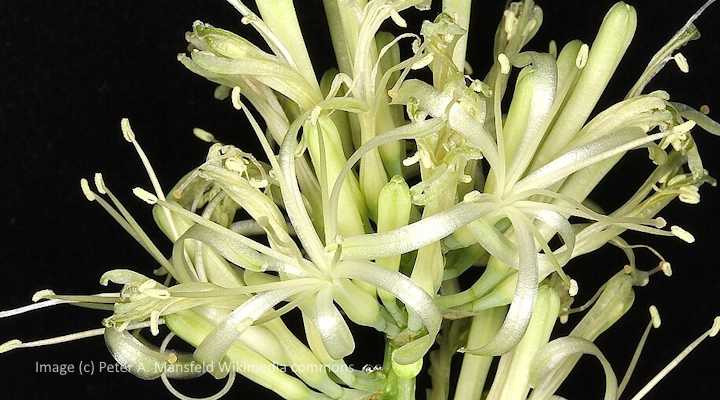
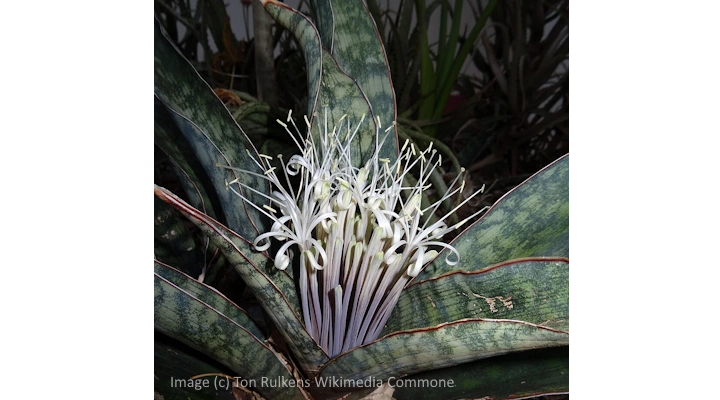
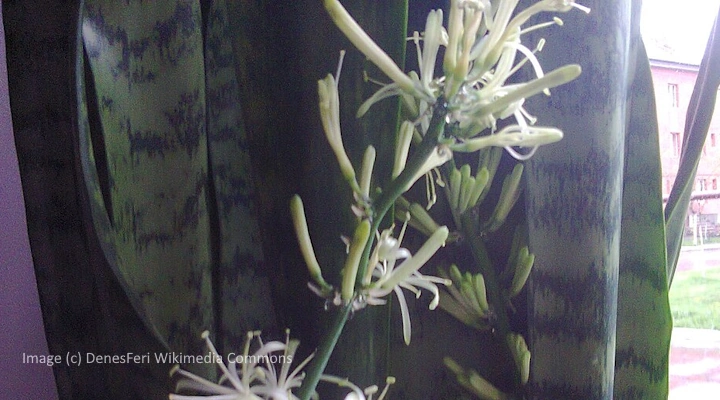

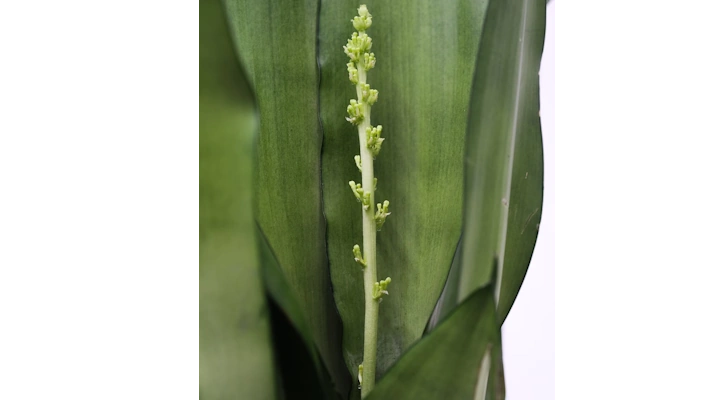


Why Do Snake Plants Bloom Indoors? (It’s Not Just Luck)
Let’s clear something up—your snake plant didn’t bloom because the moon was right or because you whispered to it daily. It bloomed because it was ready and slightly stressed out. And that’s exactly what it wanted.
What Triggers a Snake Plant to Bloom Indoors?
Snake plants bloom when conditions mimic survival threats. In their native habitat, this usually happens after winter dormancy when spring light returns. Indoors, the same can happen with tight roots, dry spells, and loads of light.

“My pot was so packed, the soil looked like it was being strangled,” a Reddit user said. “But then bam—flower spike. Like a reward for not repotting.”
Another shared, “I moved it next to a hot window for the winter and forgot it. Came back to a blooming plant and a whole lot of sticky nectar.”
Got pets at home? It’s vital to remember that flowering doesn’t change toxicity—snake plants remain unsafe for cats, so remember that all parts of snake plants are toxic to cats. So, best to keep them out of reach of your furry friend.
🌿 Want blooms? Ignore your snake plant (strategically). Root-bound + light + a plant under stress = flower fireworks.
Protect buds from curious paws. See “How to keep cats away from snake plants” for gentle deterrents, smart barriers, and cat-safe swaps that keep blooms and pets safe.
How Often Do Snake Plants Flower?
Snake plants bloom rarely — sometimes only once every few years indoors. They’re more likely to flower if slightly rootbound and getting bright, indirect light. The thing is that many varieties of snake plants never bloom indoors unless they’re slightly stressed. We’re talking rootbound or exposed to excessive sunlight.
You’ll find that snake plants bloom more frequently outdoors in their warm, native climate. You’ll typically see snake plant blooms outside in late spring or summer.
Indoor vs Outdoor Blooming Patterns
Snake plant blooms indoors feel like rare magic. Outdoors? Not quite as mythical.
In their native African climate, snake plants flower more often—usually during warm seasons with natural rainfall cycles and bright sunlight. Outdoor conditions mimic their “ideal stress”—high light, temperature shifts, and just enough drought to trigger flowering without damage.
Inside, we control almost everything. Which means fewer surprises. Your plant might never get cold enough, dry enough, or pot-bound sufficient to feel the need to flower.
One Reddit user shared, “My mom’s outdoor snake plant in Florida blooms every spring. Mine’s been inside for eight years and—nothing.” Another said, “I only saw mine bloom after I left town and the power went out. Guess the wild indoor conditions did it.”
That contrast matters. Growing outdoors, bloom cycles follow nature. Indoors, they’re unpredictable and dramatic—a plant’s way of saying, “Conditions were weird. Here’s a flower.”
At What Age Do Snake Plants Flower?
Snake plants typically flower when they’re mature, usually after several years of steady growth. Indoor plants often need to be at least four to eight years old to bloom. Flowering depends on age, but also on conditions like root crowding, bright indirect light, and mild environmental stress.
Is Flowering a Sign of Stress? Here’s What Science Says
Snake plants aren’t just surviving—they’re scheming. Seriously. That flower spike you’re seeing? It’s not a random miracle. It’s a survival strategy in full bloom.
Botanists call it stress-induced flowering, and it’s backed by science. A 2016 study published in the Journal of Experimental Botany found that plants under mild environmental stress—like limited space or water—shift from leafy growth to reproductive energy bursts (aka blooms).
In the wild, Dracaena trifasciata or Dracaena angolensi don’t waste resources on flowers unless they sense threats. Indoors, we mimic this by letting them get root-bound, dry out between waterings, or soak up intense light. That “neglect” is your plant’s cue to push out one final, fragrant hurrah before settling down.
Forum plant parents totally get this. One user on Reddit joked, “My snake plant was completely pot-bound, and I forgot to water it for weeks… suddenly, flowers.” Another shared, “It’s like it bloomed out of spite.”
Snake Plant Flowers—What Your Plant is Telling You
A snake plant bloom feels like applause—but is it a standing ovation or a goodbye?
Here’s the honest answer: it can be both.
Sometimes flowering means your snake plant’s thriving—mature, rootbound in just the right way, soaking up an abundance of light and feeling itself. Other times? It’s pulling a dramatic move in response to stress, using that bloom as a backup plan.

One Reddit grower wrote, “I panicked. Thought it meant my plant was dying. But six months later, it’s still kicking—just leafier now.” Another said, “Mine flowered after months of neglect. I thought I ruined it. Turns out it was just trying to party before repotting.”
The bloom itself doesn’t hurt the plant. But it does mean your snake plant noticed a shift—and made a move. Whether that shift came from age, stress, or tight roots, the flower is just communication.
Do Snake Plants Need Special Attention After Flowering?
You don’t need to change your snake plant care after it flowers drastically. Keep your watering light, avoid repotting immediately, and skip fertilizing for a few weeks. The plant may look tired temporarily, but with steady conditions and patience, it will return to normal growth on its own.
Remember, an indoor snake plant is a highly drought-tolerant houseplant.
In my experience, a few gentle adjustments can help it bounce back with grace, especially if you notice healthy snake plant leaves.
After flowering, snake plants sometimes slow down or look a little worn out. That’s normal. Flowering takes energy—like a long workout followed by a nap. Keep things mellow for a bit. No big changes. Let the soil dry as usual, skip the fertilizer for a month, and refrain from rushing to repot.
What to Do After a Snake Plant Blooms
- Leave the bloom alone: Don’t touch or move the flower stalk. Let it open naturally. Avoid brushing or bumping it.
- Avoid repotting: Keep the plant in its current pot during flowering. Repotting now may disrupt blooming.
- Skip fertilizer: Stop feeding while it’s blooming. Over-fertilizing can stress the plant or damage the flowers.
- Water lightly: Maintain your regular watering frequency. Let the soil dry between waterings to prevent root rot.
- Provide sufficient light: Place your plant near an east-facing window where it receives bright, indirect sunlight. Avoid direct midday rays. Snake plants need consistent sunlight per day to support healthy blooms without scorching the leaves.
- Increase air circulation: Gently ventilate the area to prevent mold on the sticky nectar. Use a fan if needed.
- Watch for insects: The sweet-smelling nectar may attract gnats or ants. Wipe any sticky residue from leaves or pots.
- Support the stalk: If the flower stalk grows tall and leans, gently support it with a stake or soft tie.
- Let it fade naturally: Once blooms fade, you can trim the stalk at the base. Don’t yank or twist it off.
One Reddit user shared, “I fertilized mine right after it bloomed, and the leaves started drooping. Now I wait.” Another said, “I left it alone after the bloom, and within weeks, I saw a baby plant peeking through.”
The bloom isn’t a reset—it’s a milestone. Treat it like recovery time. Keep your usual rhythm and give your snake plant some space to refocus on leafy growth.
🌿 After a snake plant blooms, think rest—not rescue. Water light, skip the extras, and let it recharge on its own timeline.
Should You Prune the Flower Stalk?
Yes—once the flowers fade and the stalk turns brown, prune it at the base using clean scissors. Cutting removes dead growth and helps the plant redirect energy to healthy leaves. Don’t yank the stalk, and avoid trimming while it’s still green and moist.
Will It Bloom Again? (Or Just Once?)
Snake plants can bloom more than once, but it’s rare. Most Dracaena trifasciata varieties only flower occasionally when mature and under mild stress. Re-blooming may take years, especially indoors. While not a one-time event, flowering is unpredictable and depends heavily on age, conditions, and environment.
Can You Propagate From a Flower Stalk?
No, you can’t propagate a snake plant from its flower stalk. Unlike stem cuttings or leaf divisions, the bloom isn’t a viable source of new growth. For successful snake plant propagation, divide the root-bound plant into sections or use healthy leaves planted in fresh soil.
How to Get a Snake Plant to Bloom
To get a snake plant to bloom, create mild stress by letting it become slightly rootbound, keeping it in bright indirect light, and mimicking natural seasonal changes. These drought-tolerant indoor plants flower under specific conditions, especially when mature. Avoid overwatering and fertilizer. Consistency, patience, and calculated neglect increase the chances.

Rootbound but Not Too Cramped
Snake plants love tight shoes—but not concrete boots. A slightly pot-bound snake plant feels the nudge to flower. Too rootbound, though? You’ll get stunted growth and crunchy tips. Keep it snug in a well-draining pot, and check roots once a year to make sure they’re not gasping for space.
Bright Light Without Direct Sunlight
Bright, indirect light is their sweet spot. Think east-facing window, sheer curtain, or a reliable grow light. Insufficient light? No bloom. Too much sun? Burned, crispy edges. Keep your snake plant in a space with strong daylight but zero harsh rays—and it might just feel bold enough to bloom.
Mimicking Seasonal Change (Light Conditions and Temperature)
In nature, snake plants bloom after dry, cooler months roll into spring. Indoors, mimic that shift. Ease up on watering during winter dormancy, then reintroduce warmth and longer light in spring. One Reddit user said, “I changed nothing except moving it closer to a sunny window—and boom. Flowers.”
Stress Without Harm: Calculated Neglect
This one’s an art. Skip a watering. Let the soil get desert-dry. Hold off on feeding. That controlled stress tells your snake plant, “It’s now or never.” But don’t ghost it entirely—too much stress leads to sad, floppy leaves and fungal drama. Stress it lightly to create the ideal conditions for blooming.
Snake Plant Varieties That Are More Likely to Bloom
Not all snake plants bloom equally, and some are more dramatic than others. If you’re hoping for flowers, start with a mature plant that’s a little root-bound, soaking up bright light, and chilling in a cozy pot with just enough stress to keep it on edge.
Here are five bloom-prone beauties to watch:
- Dracaena trifasciata’ Laurentii’ – That classic, stripy queen you see in every houseplant stock video. She’s bold, hardy, and blooms best when slightly ignored.
- Cylindrical Snake Plant (Dracaena angolensi) – Round leaves, sculptural vibes, and a habit of flowering in dry, sandy soil. Total farm-plant energy with a glow-up.
- Dracaena trifasciata ‘Moonshine’ – Pale, ghosty, and way underrated. This nest snake plant stays quiet until—surprise—it throws a bloom like it’s nothing.
- Dracaena cylindrical ‘Boncel’ – A compact, misunderstood houseplant with a soft spot for containers. Stiff, stubby leaves + the right stress = a rare, low-key flower show.
- Dracaena patens – A wild, wavy type that thrives outdoors but might show off indoors with intense light and a tight fit.
Looking for proof? One grower on Reddit said their 75-year-old snake plant finally bloomed after years of low-fuss care. Others swear by “planting into sections” or waiting until spring to give these perennial plants the best shot.
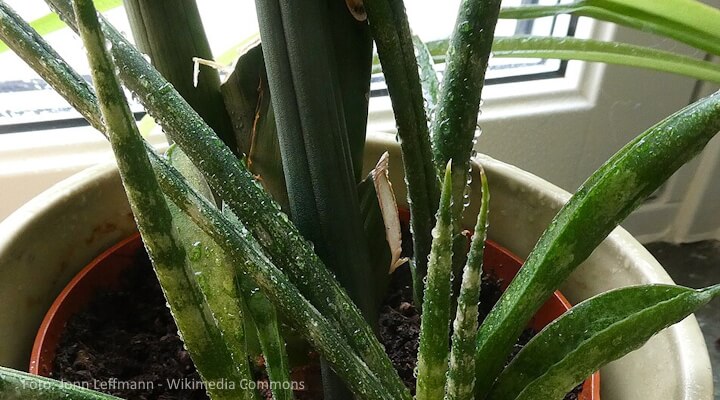
For best results, plant in spring, avoid wet soil, and allow the entire plant to experience dry conditions between waterings. A balanced NPK 10-10-10 houseplant fertilizer used sparingly may help maintain healthy snake plant leaves without overstimulating growth.
Rare Snake Plant Cultivars and Collector Favorites
Beyond common snake plant varieties, some rare cultivars offer unique foliage and higher bloom potential under the right conditions. These distinct plants are popular among collectors and may surprise you with a flower if kept as a mature plant in optimal conditions.
Collector-Favorite Rare Snake Plant Cultivars:
- Dracaena trifasciata ‘Bantel’s Sensation’: Tall, narrow leaves with crisp white vertical striping. This low-maintenance container plant may bloom in bright light and dry conditions.
- Dracaena trifasciata ‘Whitney’: A compact cultivar with deep green and silvery variegation. Best kept slightly root-bound in loose, well-drained potting soil mix.
- Dracaena trifasciata ‘Silver Blue’: Smooth, blue-gray leaves with strong plant fiber and slow growth. Rarely found in farm plant collections but may flower indoors under sufficient light.
- Dracaena hanningtonii: A hardy, upright form sometimes mistaken for a cylindrical snake plant. This plant type may bloom when root-bound and grown in sandier soil.
- Dracaena pearsonii: Also called the “Rhino Grass,” it’s a drought-tolerant ornamental plant with paddle-shaped leaves. Requires dry conditions and indirect light to thrive.
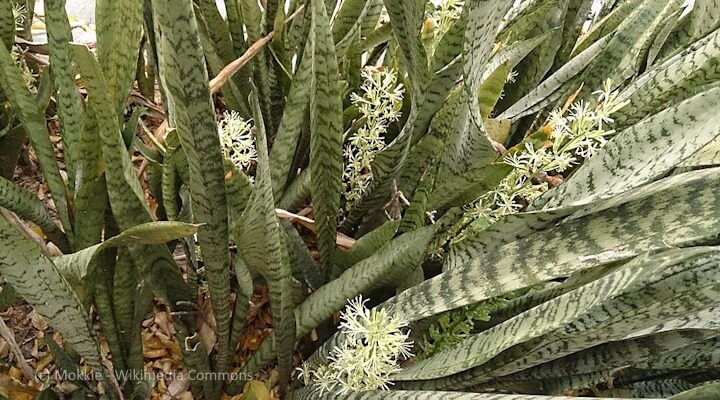
Most of these plants are misunderstood houseplants—often overlooked for their subtle foliage but treasured by enthusiasts. Provide ample indirect light, avoid wet soil, and use clean water to support healthy snake plant leaves and eventual blooming.
Do Snake Plant Flowers Have a Special Meaning?
Snake plant flowers often represent resilience, protection, or good luck. Whether it’s a sign of great care or gentle stress, it’s always a rare treat.
Snake Plant Flowers: Cultural and Symbolic Meaning
Snake plant flowers are rare and often seen as a symbol of resilience, protection, and hidden potential. In some cultures, their sudden appearance is linked to good luck, while others see it as a sign of stress or transition. Interpretations vary, but the bloom always sparks curiosity and emotion.
In folklore, the snake plant itself (often still called Sansevieria or mother-in-law’s tongue) has a bit of mystique. Some cultures see it as a protector—sharp leaves warding off bad energy. So when it flowers? That’s often taken as a sign of spiritual cleansing or renewal.
Others go the opposite way: “My aunt swears the bloom is a death omen,” one Reddit user said. “She moved the plant outside the minute it flowered.” Another joked, “If mine dies, I want it written on my headstone that it bloomed first.”
The truth is probably somewhere in between. These blooms are rare, unexpected, and emotionally charged. Whether you see it as a spiritual wink or just a biological fluke, one thing’s for sure—it leaves a lasting impression.
Snake plant blooms come wrapped in myth. Some say they’re auspicious. Some say warning. Either way, it means your beautiful snake plant had something to say.
Snake Plant Flowers: FAQs
Do snake plants really flower?
Yes, they do—but it’s rare indoors. When it happens, you’ll see tall stalks with tiny, creamy-white flowers that release a strong scent at night. It usually means your plant is mature and mildly stressed (like rootbound).What triggers a snake plant to bloom?
Snake plants often flower after experiencing mild root stress or prolonged bright light. It’s more likely in spring or early summer and tends to happen when the plant is slightly neglected or rootbound.Is it bad if my snake plant flowers?
Not at all. It’s a natural part of the plant’s lifecycle. You can enjoy the blooms while they last, then snip the flower stalk once it wilts. It doesn’t hurt your plant—but it may signal the need for a bigger pot or gentler care.Should I cut off the flower stalk?
You don’t have to—but once the bloom fades, it’s safe to prune. Cutting it back helps redirect energy to leaf growth. Use clean shears and trim the stalk near the base.Are Snake Plant Flowers Safe Around Pets and Kids?
Snake plant flowers are non-toxic to touch, but the plant itself is mildly toxic if ingested. The flower’s sticky nectar is generally harmless, but ingestion may cause minor upset in pets or small children. Keep snake plants out of reach if safety is a concern.If your pet licks or ingests the nectar, monitor them for mild digestive upset. In most cases, the effects are minor. Offer fresh water and consult your vet if symptoms like vomiting or drooling appear. Always wipe sticky nectar from nearby surfaces.
Snake plant blooms are rare—but they’re still toxic to pets. Find out how dangerous they are for cats in our vet-informed guide.
Are Snake Plant Blooms Toxic?
The blooms themselves are not considered toxic. However, the entire plant contains saponins, which can cause nausea or vomiting in pets if eaten. While the flower isn’t dangerous on its own, avoid letting pets chew on the plant or lick dripping nectar.Why Did Mine Bloom This Year and Not Last Year?
Snake plants bloom in response to specific conditions: maturity, light, and mild stress. If your plant received more light, became more root-bound, or experienced drier soil this year, those subtle changes may have triggered flowering. It’s unpredictable, and often seasonal or situational.Can Snake Plants Bloom in Low-Light Environments?
Snake plants can survive in low-light environments but rarely bloom without sufficient light. Insufficient light limits energy for flowering. To encourage blooms, move the plant to a bright room with indirect sunlight or place it near an east-facing window. Consistent light is essential for bloom development.How Long Do Snake Plant Flowers Last?
Snake plant blooms typically last 2 to 4 weeks. Flowers may open at night and gradually fade over several days. Once the blooming cycle ends, the stalk will dry out and can be pruned. Proper care during this time helps the plant recover faster.Do Snake Plants Die After Blooming?
No, snake plants do not die after blooming. Unlike some succulents that flower once and die, snake plants continue to grow after flowering. However, they may slow down temporarily while recovering. Resume normal care and avoid repotting immediately after a bloom.Should I Fertilize During or After Bloom?
Avoid fertilizing during bloom. Wait at least 4–6 weeks after flowers fade before applying fertilizer. A balanced NPK 10-10-10 houseplant fertilizer can support recovery, but overfeeding too soon may cause stress. Let the plant rest before resuming any feeding schedule.Do Snake Plant Flowers Attract Pests or Mold?
Yes, blooming can attract pests like gnats or ants due to the sticky nectar. Poor air circulation may also encourage mold around the flower stalk. Wipe residue from leaves, provide airflow, and inspect regularly to prevent insects or fungal issues during bloom.Snake plant flowers are uncommon, fragrant, and often unexpected. They don’t mean your plant is dying—they’re a natural response to maturity and environment. With the right care and a bit of luck, your low-maintenance container plant may bloom again someday. Until then, enjoy the leaves.
